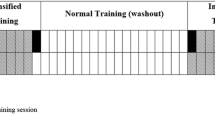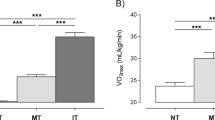Abstract
The purpose of the present study was to determine whether 12 months of moderate intensity cycling would increase the expression of IL-2 (CD25+) receptors in T helper (CD4+) lymphocytes in men and women aged 65–75 years. Fourteen men and 10 women completed 52 weeks of moderate intensity cycling (60% VO2peak). Subjects trained (TR) three times per week for 45 min per session. Eight age-matched untrained (UT) male and eight UT female subjects acted as controls. Resting blood samples were taken from TR and UT subjects every 4 weeks. Leukocyte concentration was measured using a full blood count. PHA-stimulated CD4+ lymphocytes were analysed for changes in the expression of CD25+, by flow cytometry. Training significantly increased VO2peak (l min−1, ml kg−1 min−1) in male (+14.3, +16%) and female (+16.7, +27.8%) groups. The TR male group showed a significantly lower percentage of CD4+CD25+ than the male UT in January but the TR male percentage was significantly higher than the UT male group during February, March, April, May, June, September B and December. The female TR group showed a significantly higher percentage CD4+CD25+ than the female UT only during July. There were also significant sequential monthly changes in the percentage of CD4+CD25+ for male and female UT and TR groups. Significant increases in the percentage of CD4+CD25+ in the male TR group suggest training-enhanced lymphocyte mitogenic responsiveness. Moderate intensity long-term training may increase the recruitment of active memory CD4+CD25+ in men rather than women.



Similar content being viewed by others
References
Ahluwalia N, Mastro A, Ball R, Miles M, Rajendra R, Handte G (2001) Cytokine production by stimulated mononuclear cells did not change with aging in apparently healthy, well-nourished women. Mech Ageing Dev 122:1269–1279
Brock M (1987) Age-related changes in circannual rhythms of lymphocyte blastogenic responses in mice. Am J Physiol 252:299–305
Bruunsgaard H, Pedersen BK (2000) Effects of exercise on the immune system in the elderly population. Immunol Cell Bio 78:523–531
Ceddia M, Price E, Kohlmeier C, Evans J, Lu Q, McCauley E, Woods J (1999) Differential leukocytosis and lymphocyte mitogenic response to acute maximal exercise in the young and old. Med Sci Sports Exerc 31(6):829–836
Crist D, Mackinnon L, Thompson R, Atterbom H, Egan P (1989) Physical exercise increases natural cellular-mediated tumour cytotoxicity in elderly women. Gerontology 35:66–71
Fahlman M, Boardley D, Flynn M, Braun W (2000) Effects of endurance training on selected parameters of immune function in elderly women. Gerontology 46(2):97–105
Gueldner S, Poon L, La Via M, Virella G, Michel Y, Bramlett M, Noblr C, Paulling E (1997) Long term exercise patterns and immune function in healthy older women. A report of preliminary findings. Mech Ageing Dev 93:215–222
Maes M, Stephens W, Scharpe S, Bosmans E, De Meyer F, D’Hondt P, Peeters D, Thompson P, Cosyns P, De Clerck L, Bridts C, Neels H, Wauters A, Cooreman W (1994) Seasonal variation in peripheral blood leukocyte subsets and in serum interleukin-6 and soluble interleukin-2 and -6 receptor concentrations in normal volunteers. Experientia 50:821–828
Maes M, Mommens K, Hendricks D, Peeters D, D’Hondt P, Ranjan R, De Meyer F, Scharpe S (1997) Components of biological variation, including seasonality, in blood concentrations of TSH, TT3, FT4, PRL, cortisol and testosterone in healthy volunteers. Clin Endocrinol 46:587–598
Mann D, Akinbami M, Gould K, Ansari A (2000) Seasonal variations in cytokine expression and cell-mediated immunity in male rhesus monkeys. Cell Immunol 200(2):105–115
Mooren F, Bloming D, Lechtermann A, Lerch M, Volker K (2002) Lymphocyte apoptosis after exhaustive and moderate exercise. J Appl Physiol 93:147–152
Neckers L, Cossman J (1983) Transferrin receptor induction in mitogen-stimulated human T lymphocytes is required for DNA synthesis and cell division and is regulated by interleukin 2. Proc Natl Acad Sci USA 80:3494–3498
Nieman D, Henson D, Gusewitch G, Warren B, Dotson R, Butterworth D, Nehlsen-Cannarella S (1993) Physical activity and immune function in elderly women. Med Sci Sports Exerc 25:823–831
Pati A, Florentin I, Chung V, De Sousa M, Levi F, Mathe G (1987) Circannual rhythm in natural killer activity and mitogen responsiveness of murine splenocytes. Cell Immunol 108:227–234
Rhind S, Shek P, Shinkai S, Shephard R (1994) Differential expression of IL-2 receptor alpha and beta chains in relation to NK cell subsets and aerobic fitness. Int J Sports Med 15(6):911–918
Schindowski K, Frohlich L, Maurer K, Muller W, Eckhert A (2001) Age-related impairment of human T lymphocytes’ activation: specific differences between CD4+ and CD8+ subsets. Mech Ageing Dev 123:375–390
Shinkai S, Kohno H, Kimura K, Komur T, Asai H, Inai R, Oka K, Kurokawa Y, Shephard R (1995) Physical activity and immune senescence in men. Med Sci Sports Exerc 27(11):1516–1526
Smith T, Kennedy S, Fleshner M (2004) Influence of age and physical activity on the primary in vivo antibody and T cell-mediated responses in men. J Appl Physiol 97:491–498
Song L, Young H, Chopra R, Proust J, Nagel J, Nordin A, Adler W (1993) Age-related effects in T cell activation and proliferation. Exp Gerontol 28(4–5):313–321
Wang H-Y, Bashore T, Tran Z, Friedman E (2000) Age-related decreases in lymphocyte protein kinase C activity and translocation are reduced by aerobic fitness. J Gerontol 55(11):545–551
Whisler R, Beiqing L, Chen M (1996) Age-related decreases in IL-2 production by human T cells are associated with impaired activation of nuclear transcriptional factors AP-1 and NF-AT1. Cell Immunol 169(2):185–195
Woods J, Ceddia M, Wolters B, Evans J, Lu Q, McCauley E (1999) Effects of 6 months of moderate aerobic exercise training on immune function in the elderly. Mech Ageing Dev 109:1–19
Yan H, Kuroiwa A, Tanaka H, Shindo M, Kiyonaga A, Nagayama A (2001) Effect of moderate exercise on immune senescence in men. Eur J Appl Physiol 86(2):105–111
Acknowledgments
The authors would like to acknowledge the contributions made to the study by Dr Norman Morris and Dr Bon Gray of Griffith University, Gold Coast, QLD, Australia.
Author information
Authors and Affiliations
Corresponding author
Rights and permissions
About this article
Cite this article
Broadbent, S., Gass, G. Aerobic training increases the stimulated percentage of CD4+CD25+ in older men but not older women. Eur J Appl Physiol 103, 79–87 (2008). https://doi.org/10.1007/s00421-007-0664-8
Accepted:
Published:
Issue Date:
DOI: https://doi.org/10.1007/s00421-007-0664-8




